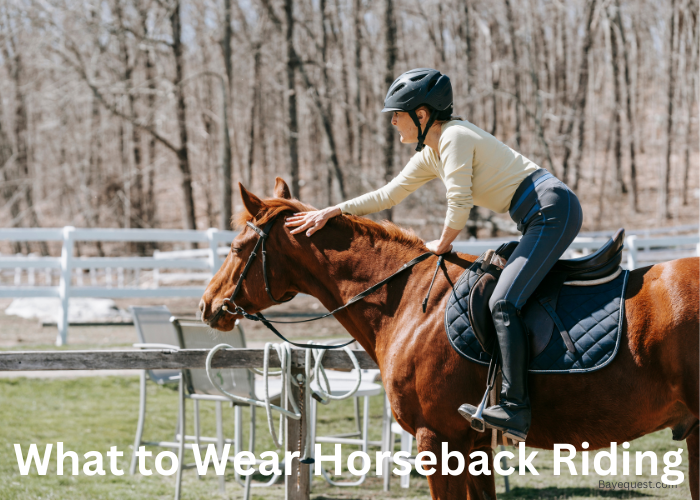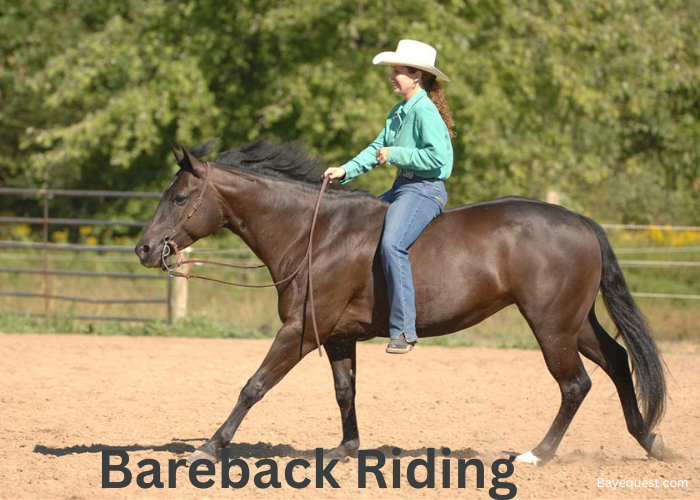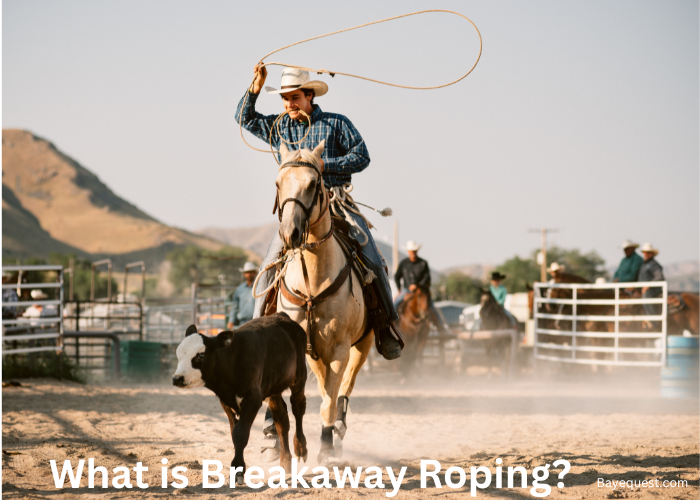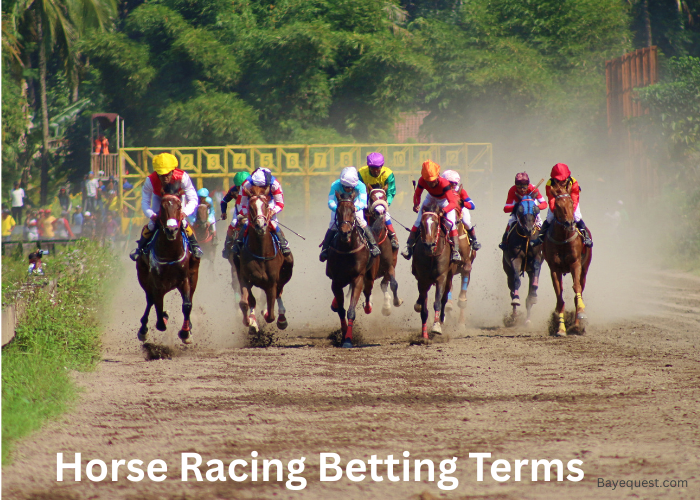Not sure what to wear for horseback riding? You’re not alone.
Riding a horse isn’t just about style. It’s about safety and comfort too.
The right outfit can make your ride smooth and enjoyable. The wrong one? Not so much.
Whether you’re a beginner or a seasoned rider, your clothing matters. Tight jeans, slippery shoes, or loose tops can cause problems.
You don’t need fancy gear, just smart choices.
Let’s go over what to wear horseback riding so you can ride in comfort, stay safe, and enjoy every moment in the saddle.
Importance of Wearing Appropriately for Horseback Riding
A horseback riding is like a dance with your horse. You wouldn’t wear flip-flops to a tango, right?
What you wear in the saddle matters, and here’s why:
1. Safety first
Your outfit can save you from accidents. A helmet shields your head from unexpected falls.
Boots with a heel? They keep your feet from slipping through the stirrups. It’s like wearing armor, but way cooler.
2. Comfort is key
Riding isn’t just sitting, it’s moving, balancing, and sometimes bouncing. Tight jeans or bulky jackets? Big nope.
Go for gear that lets you move, breathe, and stay comfy, whether it’s a sunny trail ride or a chilly morning in the arena.
3. Weather-proof your ride
Nature doesn’t care if you’re on a horse. Rain, cold, or heat, dress for it.
Layers for the cold, breathable fabrics for the heat, and waterproof gear for rain. Riding should feel like an adventure, not a weather battle.
4. Better control, better ride
Your clothing can help you connect with your horse. Riding pants give you grip.
Gloves help you handle reins without blisters. Boots keep your feet steady in the stirrups. It’s all about riding smarter, not harder.
5. Ride without distractions
The wrong outfit can ruin the moment. If your clothes are pinching, slipping, or making you sweat buckets, it’s hard to enjoy the ride.
Dress right, and you’ll focus on what matters, bonding with your horse.
What to Wear Horseback Riding
When getting ready to ride, you must learn that style also matters a lot. Let me break it down, one piece at a time.
Tops
Think comfort and practicality. A breathable t-shirt or long-sleeve shirt is your best friend.
You want something snug enough that it doesn’t flap around but not so tight that it limits your movement.
In colder weather, layering is key. Start with a thermal top and add a lightweight jacket or vest.
Avoid hoodies or bulky coats as they can get caught on reins or the saddle.
Remember, you’ll be moving a lot, so pick fabrics that wick sweat and keep you cool.
Bottoms
Say goodbye to shorts and skirts for this one.
Riding pants, like breeches or jodhpurs, are designed for the job. They reduce friction and give you the stretch you need.
If you prefer jeans, make sure they’re snug and have minimal seams. Loose or baggy bottoms can cause discomfort and even saddle sores.
Riding is all about feeling at ease, and the right pants make a huge difference.
Footwear
Your footwear can make or break your ride. Riding boots with a small heel (about 1 inch) are ideal.
The heel keeps your feet from slipping through the stirrups, while sturdy materials protect you if your horse accidentally steps on you.
Tall boots provide extra support for English riding, while paddock boots are versatile for all-around use.
Sneakers, sandals, or flats? A big no—they’re unsafe and can ruin your experience.
Helmet
A riding helmet is an absolute must. It’s like a seatbelt for your head.
Certified helmets are designed to handle impact and keep you safe if you fall.
They’re lightweight, adjustable, and come in styles for every type of rider. Even the best riders wear helmets—it’s not about skill, it’s about safety.
Leave bike helmets at home. They don’t provide the same level of protection.
Gloves
Riding gloves aren’t just a fashion statement—they’re a game changer. They protect your hands from blisters caused by gripping the reins.
They also improve your grip, especially in wet or sweaty conditions. Leather gloves are durable, while synthetic ones are breathable and lightweight.
Gloves help you stay in control, and they’ll make you feel more confident as you ride.
Body protectors
For an extra layer of safety, body protectors are a great choice. These vests are designed to absorb impact if you fall.
They protect your chest and back, making them especially useful for jumping or young riders.
Modern protectors are lightweight and don’t restrict your movement. If you’re nervous about riding, wearing one can give you added peace of mind.
Special Attire for Different Riding Disciplines
Horseback riding comes in many styles, and each discipline has its dress code.
Here’s a breakdown of what to wear for different riding styles:
English riding
English riding calls for a polished and elegant look.
Breeches or jodhpurs. These snug-fitting pants reduce friction and allow for better grip in the saddle.
Tall boots or half chaps. Tall boots give a classic look for competitions, while half chaps pair well with paddock boots for casual rides.
Shirts and jackets. For formal events, wear a fitted riding jacket over a collared shirt. Stick to neutral or dark colors for a sleek appearance.
Accessories. Gloves are essential, and a certified helmet is non-negotiable for safety.
Western riding
Western riding is all about comfort and practicality with a touch of cowboy flair.
Jeans. Go for fitted, durable jeans that won’t bunch up or rub uncomfortably in the saddle.
Western boots. These sturdy boots have a pronounced heel to keep your feet secure in the stirrups.
Western shirt. Button-up or snap-front shirts are the standard. They’re durable and look great, whether plain or embroidered.
Optional accessories. A cowboy hat is the classic choice, but make sure it fits well so it doesn’t fly off mid-ride.
Trail riding
Trail riding is about adapting to nature and staying comfortable for long hours in the saddle.
Comfortable pants. Breeches, jodhpurs, or jeans work well, depending on your preference.
Layered clothing. Trails can take you through changing weather, so dress in layers. A moisture-wicking base layer and a lightweight jacket are ideal.
Sturdy boots. Choose boots that can handle rough terrain and protect your feet.
Weather accessories. A wide-brimmed hat or helmet cover provides sun protection. A raincoat or poncho is a lifesaver in wet weather.
Jumping and eventing
Jumping disciplines prioritize safety and mobility.
Fitted breeches. These allow flexibility and won’t interfere with your movements.
Tall boots. Essential for grip and stability in the stirrups.
Body protector. A must-have for cross-country and jumping events to protect your torso.
Helmet. A certified, snug-fitting helmet is critical for safety.
Dressage
Dressage combines precision and elegance, and the attire reflects this.
Formal breeches. Usually white or light-colored.
Show jacket. Tailored, often black or navy, for a sleek, formal look.
Tall boots. Polished leather boots complete the outfit.
Accessories. Gloves, a stock tie, and a helmet are all standard requirements.
Racing
Racing outfits are built for speed and performance.
Silks. Lightweight and colorful to represent the jockey’s stable.
Jockey pants. Close-fitting and designed for aerodynamic efficiency.
Riding boots. Lightweight with a secure grip.
Helmet and goggles. These protect the jockey’s head and eyes during high-speed rides.
Read also: Cowboy Outfit Ideas.
What Not to Wear Horseback Riding
The wrong outfit can make your ride uncomfortable, unsafe, and even dangerous in horseback riding.
Here’s a list of things you should avoid wearing, and why they’re better left in the closet.
Heels
Leave your fashion heels at home. They’re a disaster waiting to happen in the saddle.
High heels can’t fit securely in the stirrups and increase your risk of slipping or falling.
Stick to boots with a small, functional heel designed for riding. Save your stilettos for the dance floor, not the barn.
Shorts
Riding in shorts may sound fine on a hot day, but it’s a recipe for discomfort. Saddles are rough, and your bare legs will suffer from chafing and pinching.
Even on a short ride, the friction can leave you sore and miserable. Riding pants or jeans are a much better choice.
Flip-flops
Flip-flops are a definite no. They provide zero protection and no grip.
If your horse steps on your foot (it happens!), you’ll regret wearing open-toed shoes.
Plus, they can slip off in the stirrups, creating a major safety hazard. Riding boots are a must for secure footing and safety.
Tres chic fashion statements
Flowy dresses, skirts, or your trendiest runway pieces might look fabulous, but they’re not practical.
Loose, stylish clothing can get caught on the saddle, reins, or branches during a trail ride.
Riding is about comfort and function, not a fashion show.
Baggy clothing
Baggy shirts and pants may feel cozy, but they’re a poor choice for riding. Loose fabrics can get snagged on saddle parts or gear.
They also make it harder to move freely and stay balanced. Stick to snug-fitting attire that moves with you.
Dangling accessories
Say no to long necklaces, hoop earrings, or bracelets that jingle. Dangling accessories can spook your horse or get caught in reins or tack.
It’s better to leave your jewelry behind to avoid accidents or distractions.
Bright-colored clothing
Horses can be sensitive to bright, flashy colors or patterns. While your neon pink jacket might look fun, it could make your horse uneasy or nervous.
Opt for neutral or muted tones that help you blend in with your surroundings.
Yoga pants or leggings
Yoga pants and leggings might seem like a good idea because they’re stretchy, but they lack durability.
The thin material can wear out quickly, especially against the saddle, and they don’t provide the grip you need while riding.
Stick to riding-specific pants designed for comfort and function.
Interesting read: Creative Horse Costume Ideas.
What to Wear When Riding a Horse: FAQs
Is there a dress code for a rodeo?
Yes, there is a sort of dress code for a rodeo, though it’s more about tradition than strict rules. Rodeos are steeped in Western culture, so what you wear isn’t just about style, it’s about fitting in with the vibe.
Can I ride in regular jeans?
Yes, but only if they are fitted and have minimal seams. Baggy or overly stiff jeans can cause discomfort and limit your movement. Riding pants or breeches are a better option.
What’s the difference between paddock boots and tall boots?
Paddock boots are ankle-height and great for everyday riding, while tall boots provide extra leg support and are typically worn for formal English riding or competitions. Both are functional but suit different needs.
What to Wear Horseback Riding: Conclusion
Dressing right for horseback riding isn’t just about style. It’s about safety, comfort, and confidence.
The right gear keeps you protected, helps you stay comfortable, and lets you focus on enjoying the ride.
Whether you’re a beginner or an experienced rider, investing in proper attire makes all the difference.
From helmets to boots, every piece plays a role in keeping you safe and prepared.
Gear up, saddle up, and make every ride a great one. When you’re dressed for success, the adventure is all yours.
Next, check out our blog on Halloween costumes for horse and rider and find the perfect outfit to make your next ride both festive and unforgettable.








